Sorry, this entry is only available in European Spanish.
(Español) 10 Semanas Solares Térmicas
Este cronograma representa la dosificación recomendada de dedicación para una correcta asimilación de conocimientos durante el curso e-learning de Técnico – Comercial en Energía Solar Térmica impartido por Sopelia.
Puedes recibir esta formación íntegramente desde tu computadora, smartphone o dispositivo móvil.
Supone dedicar entre 1 y 2 horas diarias entre lunes y viernes de cada semana.
* Semana 1: Introducción a la Energía Solar
1.1) El futuro de la energía solar
1.2) El Sol
1.3) Nociones básicas de Física
* Semana 2: Introducción a la Energía Solar
1.4) Nociones básicas de Electricidad
1.5) Nociones básicas de Energía
1.6) Energía del sol
1.7) Tablas
– Resolución Test 1 y 2 y Ejercicio 1
* Semana 3: Energía Solar Térmica – Equipos
2.1.1) Colectores
2.1.2) Sujeción y anclaje
* Semana 4: Energía Solar Térmica – Equipos
2.1.3) Fluido caloportador
2.1.4) Protección de la instalación
* Semana 5: Energía Solar Térmica – Equipos
2.1.5) Tuberías
2.1.6) Tanques acumuladores
2.1.7) Intercambiadores
* Semana 6: Energía Solar Térmica – Equipos
2.1.8) Grupos de bombeo
2.1.9) Aislamiento
2.1.10) Otros componentes
– Resolución Test 3 y Ejercicio 2
* Semana 7: Energía Solar Térmica – Instalaciones
2.2.1) Principios básicos
2.2.2) Diseño
2.2.3) Regulación
* Semana 8: Energía Solar Térmica – Instalaciones
2.2.4) Proyecto de un sistema de ACS
2.2.5) Cálculo de la superficie colectora
2.2.6) Cálculo de los demás elementos de la instalación
* Semana 9: Energía Solar Térmica – Instalaciones
2.2.7) Presentación de un proyecto
2.2.8) Otras aplicaciones
2.2.9) Ejecución y mantenimiento de la instalación
* Semana 10: Energía Solar Térmica – Instalaciones
– Resolución Test 4 y 5 y Trabajo Práctico final
Se trata de la formación en Energía Solar con la mejor relación calidad-precio del mercado.
Puede recibirse donde quiera que estés.
Solamente se necesita una computadora, smartphone o dispositivo móvil y conexión a Internet.
Por tratarse de la 1era edición hay un 50% de descuento sobre el PVP.
Esta acción de formación brinda capacitación técnico – comercial en aplicaciones domésticas de energía solar con el objetivo de difundir la tecnología y desarrollar recursos humanos para su incorporación al mundo laboral y empresarial.
La edición 2016 comienza el día 19 de septiembre y finaliza el día 25 de noviembre.
El plazo de inscripción es hasta el día 16 de septiembre inclusive en www.energiasrenovables.lat
Ya no tienes excusas, energía solar donde quiera que estés con Sopelia.
Free Solar Tools (IV)
On Internet we can find free tools for basic or low complexity solar systems dimensioning and for certain components or accessories estimation.
Sopelia research team has carried out an exhaustive search and testing from which a new corporate website section called Free Tools has been created.
Selected tools were classified into 4 categories.
Today we will analyze the fourth of them: Solar Photovoltaic.
In the first category we have already analyzed tools to obtain data about solar resource and other variables to be considered in energy estimation solar system will provide in our location.
In the second category we have analyzed tools to calculate the “load”, ie the energy demand to be met.
In the third category we have analyzed tools for solar thermal systems dimensioning and system accessories estimating.
Now we are going to analyze tools for solar photovoltaic systems dimensioning and to estimate others individual components of a system.
The order of the tools is not random. We have prioritized the most intuitive, the most universal and those that can be used online without download.
For this fourth category our selection is as follows:
1) Solar Calculator
Approximate calculation tool from which budget, production data and system performance study is automatically obtained.
A Navigation Guide and Manuals can be found at page bottom.

2) Off-grid Solar Systems Calculator
Free online application for off-grid solar systems calculation.
It allows users to introduce new components from any manufacturer and product datasheets to be considered in the calculation.

3) Off-grid Systems Scale Calculator
Solar basic estimation of off-grid systems. Solar modules, batteries, controller and inverter calculation.
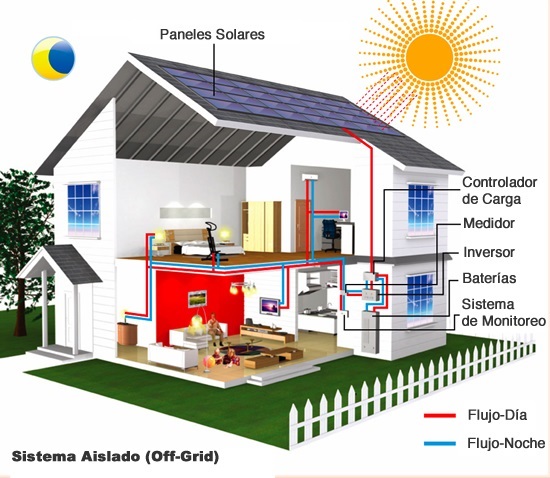
4) Solar Water Pumping Calculator
Calculator to obtain approximate energy needs figures for solar water pumping.

5) Solar & Wind Energy Systems Calculation
Tool which determines requirements to meet solar and / or wind contribution for electrification and pumping needs.

6) Grid Connected System Online Simulation
Online application to estimate production and economic income of a grid-connected system.
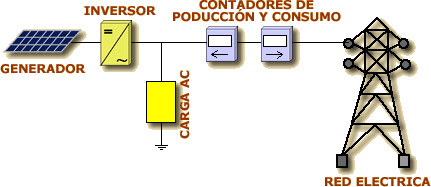
7) Battery Bank Capacity Calculator
Calculator to estimate battery bank size needed to keep consumption by solar operation.

8) Wire Section Calculator
Tool in JavaScript format for copper and aluminum DC wire calculation.

Solar energy wherever you are with Sopelia.
Solar Skills
Many times the purpose of incorporating solar energy to our professional skills, scope of business or personal life has hovered in our head.
We have almost always run into the same barrier: time.
We are working or studying and we find it very difficult to have even a few hours a week.
It is rare to find training offerings that are not too short (few hours workshops) or too long (one or more years) and which in turn have an affordable price.
If we add the difficulty of having to move, because most are taught in presence, finally we ended up postponing again and again for this purpose.
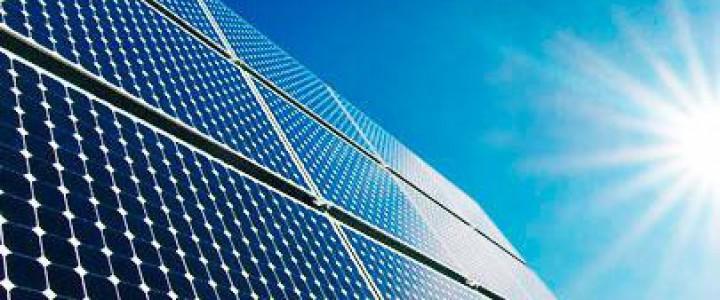
In 2014 Sopelia gave, in collaboration with the Technology National University of Mar del Plata (Argentina), the Technical – Commercial Solar Energy Course in tele-learning (distance + presence) methodology.
In 2016 Sopelia updated and divided that training action in 2 Specific courses:
* Technical – Commercial Solar Thermal Energy
* Technical – Commercial Photovoltaic Solar Energy
Sopelia rode them on a Moodle 3.1 platform and the result is 2 courses in e-learning methodology.
This means you can receive Solar Energy training with the best market value wherever you are.
You only need a PC, Smartphone or Tablet and Internet.

These two courses provide technical and commercial training in solar energy domestic applications with the aim of spreading the technology and develop human resources for incorporation into work and business world.
You will identify the most relevant aspects of solar energy within the current energy landscape.
You will define, describe and analyze the most important features of solar energy.
You will know the composition, understand the operation, design and maintenance of facilities to implement thermal and photovoltaic solar energy projects.
It is a training aimed at students and technical careers graduates, technical schools graduates, engineers, architects, professionals and installers of related sectors (air conditioning, electricity, rural), people with experience in renewable energies, environmental professionals and individuals interested in incorporating solar energy into their lives.
The 2017 1st edition starts on April 18th and ends on June 30th.
You can register until April 15th inclusive in www.energiasrenovables.lat
If you are under 35 years old and live in Latin America, with the course completed, you can apply to be Sopelia Country Manager in your country of residence.
And if you are under 30 and live in Latin America, you can get a grant of 50% and finished the course, become Sopelia Trainee.
If you speak Spanish you have no excuses, Solar Energy wherever you are with Sopelia.
Solar Cells On The Market
PV cells marketing began with monocrystalline silicon.
Based on perfectly crystallized silicon sections, they have achieved yields between 16% and 20% (24.7% in laboratory).
Later, polycrystalline silicon appeared, more economical, less efficient, but with the advantage of being able to be manufactured in a square shape; in order to take advantage of the rectangular surface available in a module.
They are based on silicon bar disorderly structured sections in small crystals form.
They have a lower performance than monocrystalline (19.8% in laboratory and 14% in commercial modules) being their price generally lower.

Then appeared thin-film technologies with similar performances to silicon modules at high temperatures or under diffuse radiation conditions.
Following are detailed thin-film modules of different semiconductor materials:
– Amorphous silicon (TFS): also based on silicon, which in this case does not follow any crystalline structure.
Usually used for small electronic devices (calculators, clocks, etc.) and small portable modules.
Its maximum yield in laboratory has been of 13% being 8% in commercial modules.
– Gallium Arsenide (GaAs): highly efficient cells to be used in special applications such as satellites, space exploration vehicles, etc.
GaAs Tandem cells are the most efficient solar cells, reaching values of up to 39%.
– Cadmium telluride (CdTe): 16% laboratory yield and 10% in commercial modules.
The drawback is that cadmium tellurium is a toxic substance. That is why manufacturing companies are working on their modules recycling process.

The next step in this evolution is represented by so-called Tandem cells that combine two or more distinct semiconductors.
Because each type of material takes advantage of only a part of solar radiation electromagnetic spectrum, by combining two or more materials it is possible to take advantage of a greater part of it.
First Tandem solar cells slope are CIGS (copper-indium-gallium-selenium).
In this case bond is not p-n type like in silicon, but a complex heterounion with which yields of 11% are obtained.
The second Tandem solar cells variant are CIS (copper-indium-selenium). With yields of 11% in commercial modules.
Another Tandem solar cells are the CZTS (copper-zinc-tin-sulfur-selenium) with yields of 9.6%.
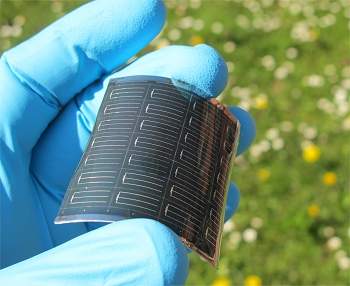
Finally we find plastic solar cells based on polymers.
They are a type of flexible solar cell that can come in many forms including organic solar cells.
They are lightweight, potentially disposable, inexpensive to manufacture (sometimes using printed electronics), customizable at molecular level and their manufacturing has less impact on the environment.
They have a yield of approximately 5% and are relatively unstable to photochemical degradation.
For this reason, the vast majority of solar cells are based on inorganic materials.
Polymer solar cells do not require sun optimum orientation as the plastic collects energy up to 70° from sun to sun axis outdoor (and in any orientation indoor).
Its application field is mainly mobile phones and laptops.
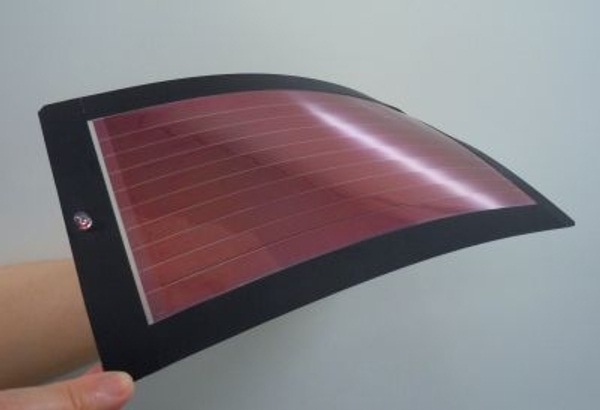
Currently underway tests to produce solar cells with new materials include colloidal quantum dots and halide perovskites.
Advances in solar energy are unstoppable and their use at a massive level depends a lot on these, as the space needed to capture a certain amount of energy will be reduced and the performance of the systems will increase.
This is an extract of contents included in Technical-Commercial Photovoltaic Solar Energy Manual and e-learning training of Sopelia.
Solar energy wherever you are with Sopelia.
Beca Solar
Si usted pertenece o representa a instituciones u organismos como los que se detallan a continuación, dispone de una beca solar para otorgar al / la beneficiari@ que el ente designe:
• Entidades académicas, educativas o de formación profesional
• Colegios o consejos profesionales
• Organismos gubernamentales de áreas medio ambiente y energías renovables
• Cámaras y asociaciones del sector energías renovables y medio ambiente
• Sindicatos, cámaras y asociaciones de los sectores electricidad y climatización
• Fundaciones con actividad en el sector medio ambiente

Para acceder a la beca solamente hay que difundir la formación e-learning solar de www.energiasrenovables.lat en los medios de comunicación habituales a través de los que la institución u organismo difunde este tipo de iniciativas.
Existe la posibilidad de recibir en metálico parte de la inscripción abonada por el/la alumn@ en caso de que la entidad beneficiaria de la beca esté abierta a una más estrecha colaboración.
Pueden enviarnos sus datos (nombre, correo electrónico, institución u organismo que representa) si desean ingresar como Invitado a la plataforma e-learning y tener acceso completo a la acción de formación.
Se trata de la formación en Energía Solar con la mejor relación calidad-precio del mercado.
Puede recibirse donde quiera que estés.

Solamente se necesita una computadora, smartphone o dispositivo móvil y conexión a Internet.
Esta acción de formación brinda capacitación técnico – comercial en aplicaciones domésticas de energía solar con el objetivo de difundir la tecnología y desarrollar recursos humanos para su incorporación al mundo laboral y empresarial.
La edición 2017 comienza el día 18 de abril y finaliza el día 30 de junio.
El plazo de inscripción es hasta el día 15 de abril inclusive en www.energiasrenovables.lat
La persona beneficiaria de la beca, si tiene menos de 35 años y vive en América Latina, finalizado el curso puede optar además a ser Country Manager Sopelia en su país de residencia.
Ya no tienes excusas, si quieres aportar tu rayito de sol para contribuir al desarrollo de la Energía Solar, tu partner es Sopelia.
Free Solar Tools (III)
On Internet we can find free tools for basic or low complexity solar systems dimensioning and for certain components or accessories estimation.
Sopelia research team has carried out an exhaustive search and testing from which a new corporate website section called Free Solar Tools has been created.
Selected tools were classified into 4 categories.
Today we will analyze the third of them: Solar Thermal.
In first category we have already analyzed tools to obtain data about solar resource and other variables to be considered in energy estimation solar system will provide in our location.
In the second category we have analyzed tools to calculate the “load”, ie the energy demand to be met.
Now we are going to analyze tools to solar thermal system dimensioning and others to estimate individual components of a system.
The order of the tools is not random. We have prioritized the most intuitive, the most universal and those that can be used online without download.
For this third category our selection is as follows:
1) Solar Thermal Calculator
Approximate calculation tool from which budget, production data and system performance study is automatically obtained.
A Navigation Guide and Manuals can be found at page bottom.

2) Simulation for Solar Thermal System Pre-design
Online application based on the TSOL software that allows solar energy system simulating to ACS and ACS + heating contribute.
Available in German, English, Spanish and French.
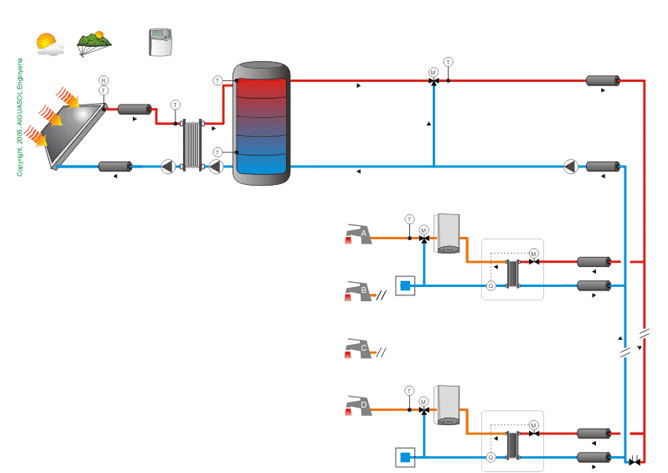
3) Solar Fraction Calculation
Free download program developed by IDAE (Institute for Energy Diversification and Saving) and ASIT (Solar Thermal Industry Association) that allows to define a wide variety of solar systems introducing a minimum of project parameters, associated to each system configuration; and in this way, obtain solar system coverage on ACS and pool conditioning energy demand.
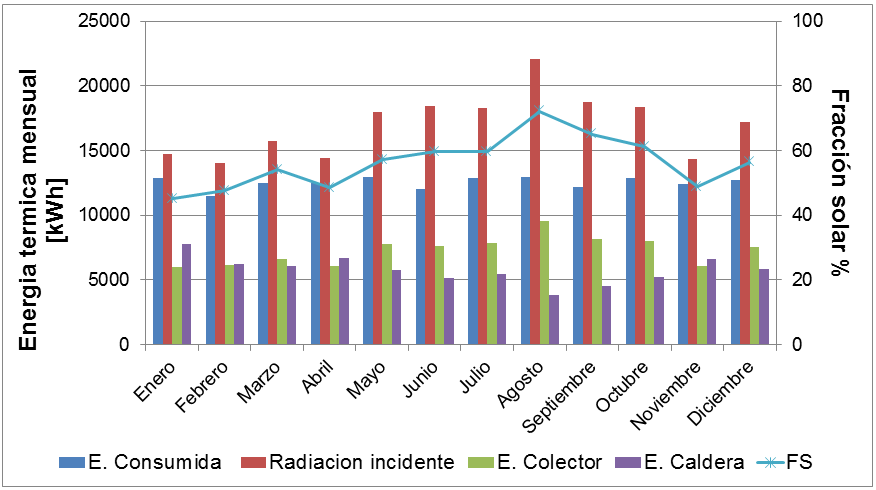
4) Solar Expansion Vessel Calculation
Tool developed to calculate solar expansion vessel volume.
Volume values (total circuit, solar collectors, pipes), Maximum system temperature (ºC), Glycol concentration (%), Height between expansion vessel and system highest point (minimum value 1 Bar) and safety valve Pressure setting must be introduced.
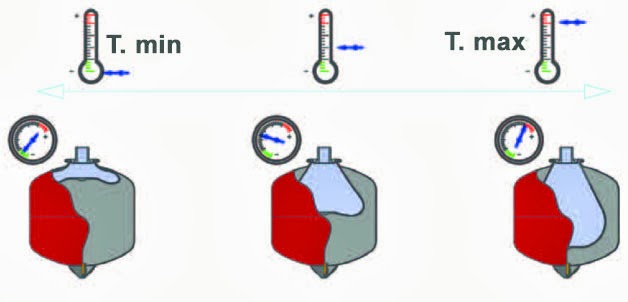
5) Thickness Insulation Pipes Calculation
Calculator that allows to estimate minimum and more economical water pipes insulation thickness.
Pipe Grade and Size, Insulation Material, Humidity and Temperature (Internal and Ambient) must be entered.
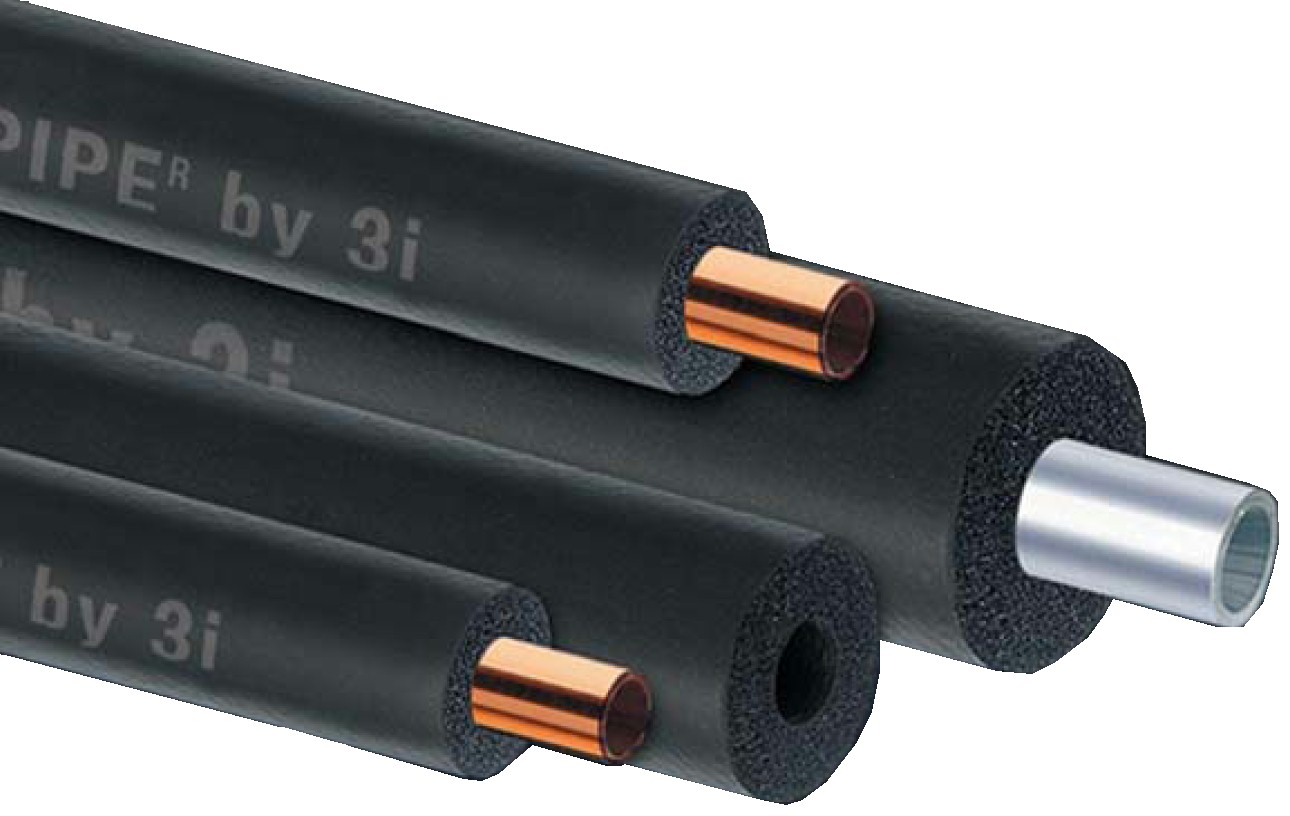
Solar energy wherever you are with Sopelia.
The Renewable Mirage Of Spain
The fact that large-scale renewable projects development started later in Latin America than in other locations, gives the region the possibility of adopting policies that have been successful in other places.
Contrary to what some may think the case of Spain is, in many ways, an example of what should not be done.
The country has only renewable native energy resources and an irrelevant carbon reserve.
Spain was the world leader in renewables and an important industrial, professional and services sector was created in the country.
Unfortunately, this development was not genuine or fruit of energy planning but the result of a custom deeply rooted in Spanish idiosyncrasy: “the pelotazo”.
Mess produced, common sense indicated to apply gradualism and long-term planning to at least preserve all that acquired know-how.
The government did the opposite.
Legal security was violated by sector regulation modifying and placed Spain on the podium of countries with most ICSID complaints.
It decreed a renewable moratorium, which has been going on for 7 years, causing small and medium-sized enterprises disappearance.
Only large companies with capacity to develop activity outside their borders survived.
In last 5 years, 1 renewable MW has not been installed.
In 2016, government has realized that it will most likely not meet European commitments made regarding renewables participation in its energy matrix.
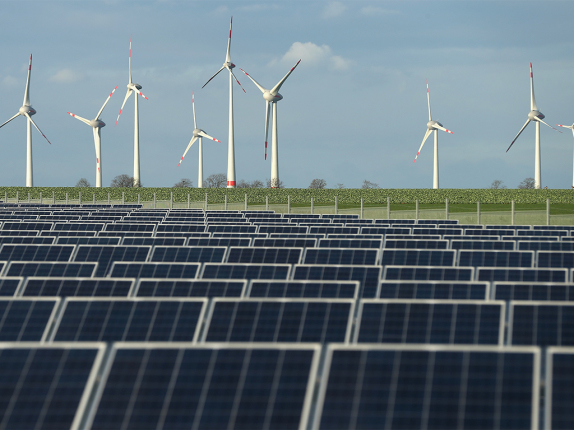
The reaction has been to present an auction draft (made public last December 28th, Holy Innocents day) which shows, once again, the energy planning lack.
In the auction project:
* A Marginalist model is proposed in which the most expensive awarded price, fixed the one of previous awards.
This favors the appearance of proposals that will present reckless bid to be adjudicated and to obtain the most expensive price offered.
This criterion opposes the PAB (pay as bid), adopted in all successful international auctions.
* An Indeterminate Variable Price is proposed, a mathematical paranormal phenomenon that reflects State intervention in private activity and the total ignorance of renewable technologies operation by those who have drafted and in 2014 sanctioned the legislation that supports it.
This criterion also goes against the Fixed Cost Price per kWh offered , adopted in all international auctions that have obtained good results.
* A Technologically Neutral criterion is adopted instead of auctioning quotas for each renewable technology.
This is very dangerous because it leaves out younger technologies that now are less profitable than others, but could be more profitable in the future; as is the case of solar thermal in which Spain is the world leader.
It also goes against Technological Specification criterion, adopted in all the international auctions that have obtained good results in order to favor the renewable energy matrix diversification and several technologies development.
* There is no size discrimination. A portion of the auctioned amount is not reserved for plants under 10 MW.
* Prequalification is not required and there is no need for real projects.
It is an absurd and unreasonable proposal that turns renewable energy into a financial product and not into an energy policy tool that promotes employment and technological and industrial development.
It favors the macro projects and deepens energy sector concentration.
At international level auctions a low price concentration is taking place, with the consequent dominant position in few actors’ creation, which in long run will dilute the advantages of short term low prices.
Surely the auction will go ahead virtually unchanged and the 3000 MW will be awarded because after 7 years without business there is real desperation in the sector.
However, that auction is a success does not mean that all projects are going to materialize nor is it a guarantee that objectives will be fulfilled.
The explosive cocktail of Variable Indeterminate Price, legal uncertainty, huge initial investment, high financial leverage and yields even lower than 4% is very dangerous.
If it explodes, who will pay for the broken dishes of this irresponsible act ? We know the answer. Spanish citizens already had to “rescue” the bank sector and “compensate” energy sector.
The option of going outside auctions is not viable because in Spain there is no legislation that encourages or allows connectivity to set PPAs between private, but “Sun Tax”.

Renewable energies grid parity is already a reality in developed countries and in some developing countries.
If aid and subsidies received from fossil fuels had been withdrawn, it would have been much earlier.
If we consider auctions as the only tool to increase renewables participation, we will be keeping an obsolete energy matrix paradigm and making a very serious error.
The energy matrix of the future is based on 3 pillars:
1) Energy efficiency
2) Renewable energies
3) Distributed generation
Real energy revolution and citizen empowerment path goes through prosumer figure and energy cooperativism development.
Concentration and energy centralization route involves only changing fossils for renewables to maintain the “statu quo” for benefit of the usual suspects, who will continue to act as a collection agency in collusion with political power of turn.
Solar energy wherever you are with Sopelia.
Solar Guatemala
In 2003, Guatemala approved the Incentives Law for Renewable Energies Generation.
In 2005 tax incentives were established for 10 years, with import taxes payment exemption for equipment, components and accessories related to projects of electric power generation from renewable sources.
In 2010, the PEG-1 Indicative Expansion Plan for Generation System was launched as part of the energy matrix transformation, with the objective of at least 60% of energy being produced through renewable resources by 2022.

Guatemala conducts auctions to award electricity and energy production contracts, in which renewable energy may have a specific quota or compete with other technologies.
Since 2012, the CNEE has held bids to hire power.
Distribution companies are the off takers.
The first tender awarded a total of 393 MW to hydroelectric (221 MW), wind (101 MW), solar (55 MW) and biomass (16 MW) plants with 15-year power purchase contracts.
The second tender, in 2014, aimed at contracting 250 MW. The auction hired 322 MW and renewable energy (solar, biomass and small hydro) were awarded 116 MW.
Auctions have been the main driver of renewable energy investment in the country.
With a total of U$D 702 million 2014 was a record year of clean energy (biomass, solar, hydroelectric and wind power plants) investment.
In 2015, the first auctioned projects began to connect to the grid.
Two large-scale photovoltaic plants (30 MW and 50 MW) were connected.
Investments declined markedly in 2015, when only the solar sector received a total of U$D 66 million.
Guatemala is the second Central American energy market, with a total generation capacity of 3.7 GW.
In 2015 it generated 10.3 TWh of electricity; of which 46% came from fossil fuel-based generation, 26% from hydroelectric and 28% from renewable energies.

Net metering distributed generation is allowed in the country.
In December 2015, 1,274 prosumers with a total installed capacity of 7.4 MW were connected to the grid.
The energy market in Guatemala has state and private actors operating in generation, transmission, trade and energy distribution segments.
The Ministry of Energy and Mines oversees electricity sector planning, while the National Electricity Commission (CNEE) is in charge of regulation. The Wholesale Market Operator organizes the system dispatch based on marginal cost of generation.
Guatemala is connected through the Central American Electric Integration System (SIEPAC) to Honduras and El Salvador, and northern Guatemala is also connected to Mexico´s transmission system.
The renewable energies installed capacity of Guatemala increased 38%, reaching 1 GW in December 2015.
The country’s average retail electricity prices fell 21% from U$D 228 / MWh in 2014 to U$D 181 / MWh in 2015.
In 2017 Guatemala is preparing a 420 MW tender for a 15-years period.
Solar energy wherever you are with Sopelia.
Thermal Solar Collector
Thermal solar collector is responsible for capturing solar radiation and converting its energy into heat energy.
A body exposed to the sun receives an energy flow Er and heats up.
Simultaneously, thermal losses occur due to radiation, convection and conduction, which grow as the body temperature increases.
There comes a time when thermal losses Ep equals the gains due to the incident energy flow, reaching the so-called equilibrium temperature:
Er = Ep
The equilibrium temperature of the collectors is usually between 100º and 150º C under normal conditions of use and for irradiation values in the order of 1,000 W / m2.
If it is possible to continuously extract a part of the heat produced Ee to take advantage of it as usable energy, the equilibrium conditions change:
Er = Ep + Ee
Ep is now smaller because a part of the energy received Er is tapped Ee.
The body has become a solar thermal collector.
If we want to increase Ee we have two options: reduce thermal losses Ep or increase energy flow Er.
First option involves collector design and construction improving in order to reduce losses.
For the second option is used the concentration technique, which by some optical system concentrates the solar flux on a smaller surface so that as the area decreases, the intensity increases.
In a solar collector the energy is extracted through a fluid called heat carrier.
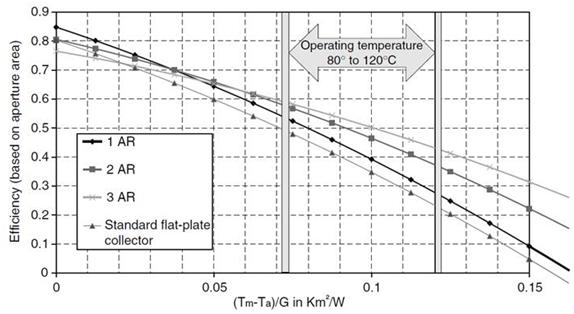
The greater the difference between operating temperature and ambient temperature, the greater the thermal losses and thus the lower energy amount that heat transfer fluid will be able to extract.
The collectors must be operated at the lowest possible temperature, provided that temperature is sufficient for the specific use in each case.
This is because collector efficiency decreases as the operating temperature increases.
Improved insulation helps thermal losses reduce.
Reflection losses are due to transparent cover that usually exists in almost all collectors.
It will be necessary to properly orient the collectors so that they receive the greatest radiation amount possible during the period of use.
The question: which is the best collector ?
A priori has no answer.
It will depend on system location and energy demand that is intended to be met.
There are many types of solar collectors, but there are two large groups: unconcentrated collectors and concentrated collectors.
Solar thermal collectors according to their working temperature:
1) Low temperatura
1.1) Flate: protected and not protected
1.2) Vacuum tubes: direct flow, heat pipe and solar concentrator CPC)
2) High temperatura
2.1) Parabolic Cylinder
2.2) Central receiver system
2.3) Parabolic disks
2.4) Solar chimney
3) Other collectors
3.1) Rubber
3.2) Spherical
3.3) Conical

In next posts we will analyze in detail each collector type.
This content was extracted from the Solar Thermal Energy Technical-Commercial Manual and is part of Solar e-learning.
Solar energy wherever you are with Sopelia.
